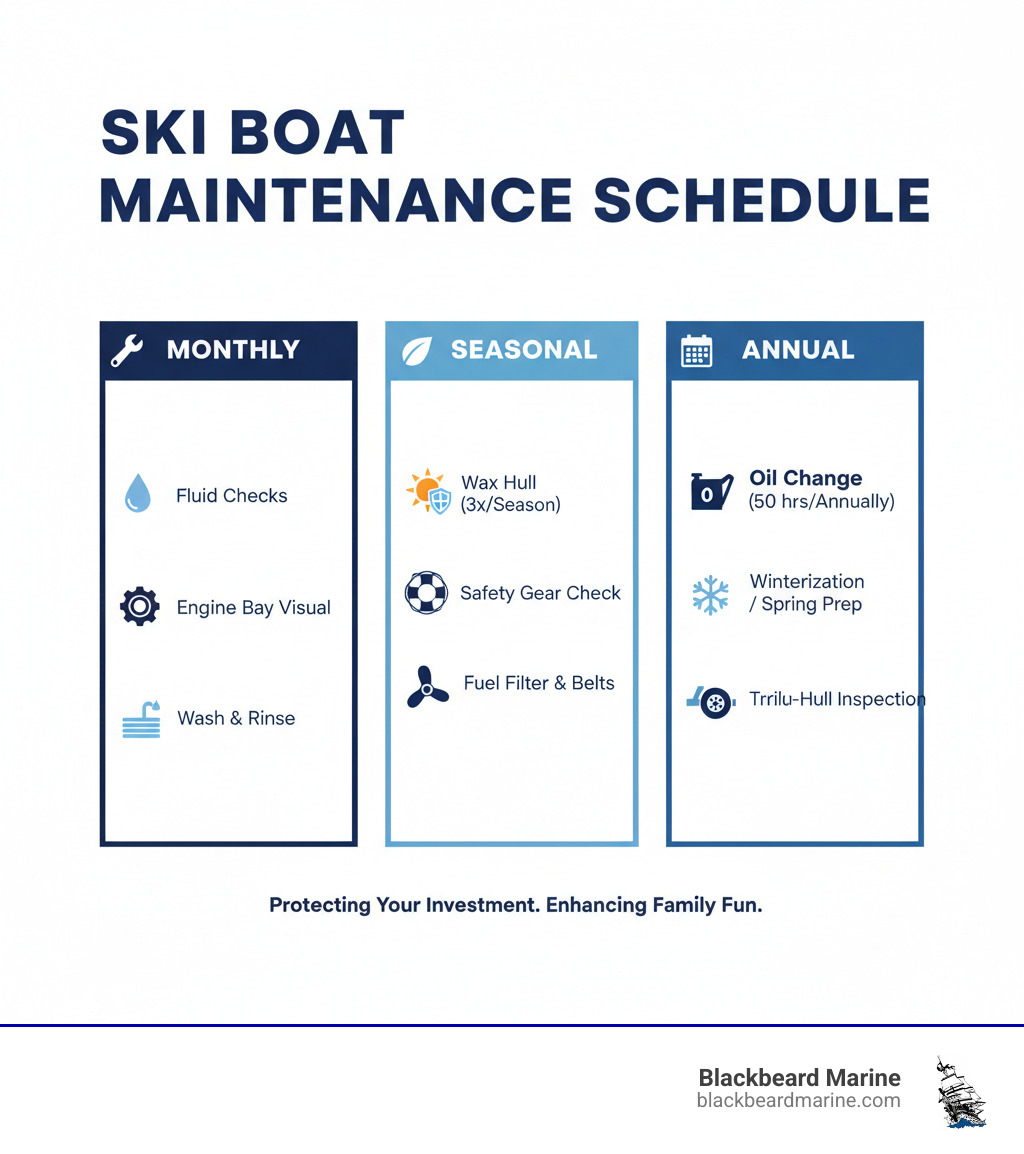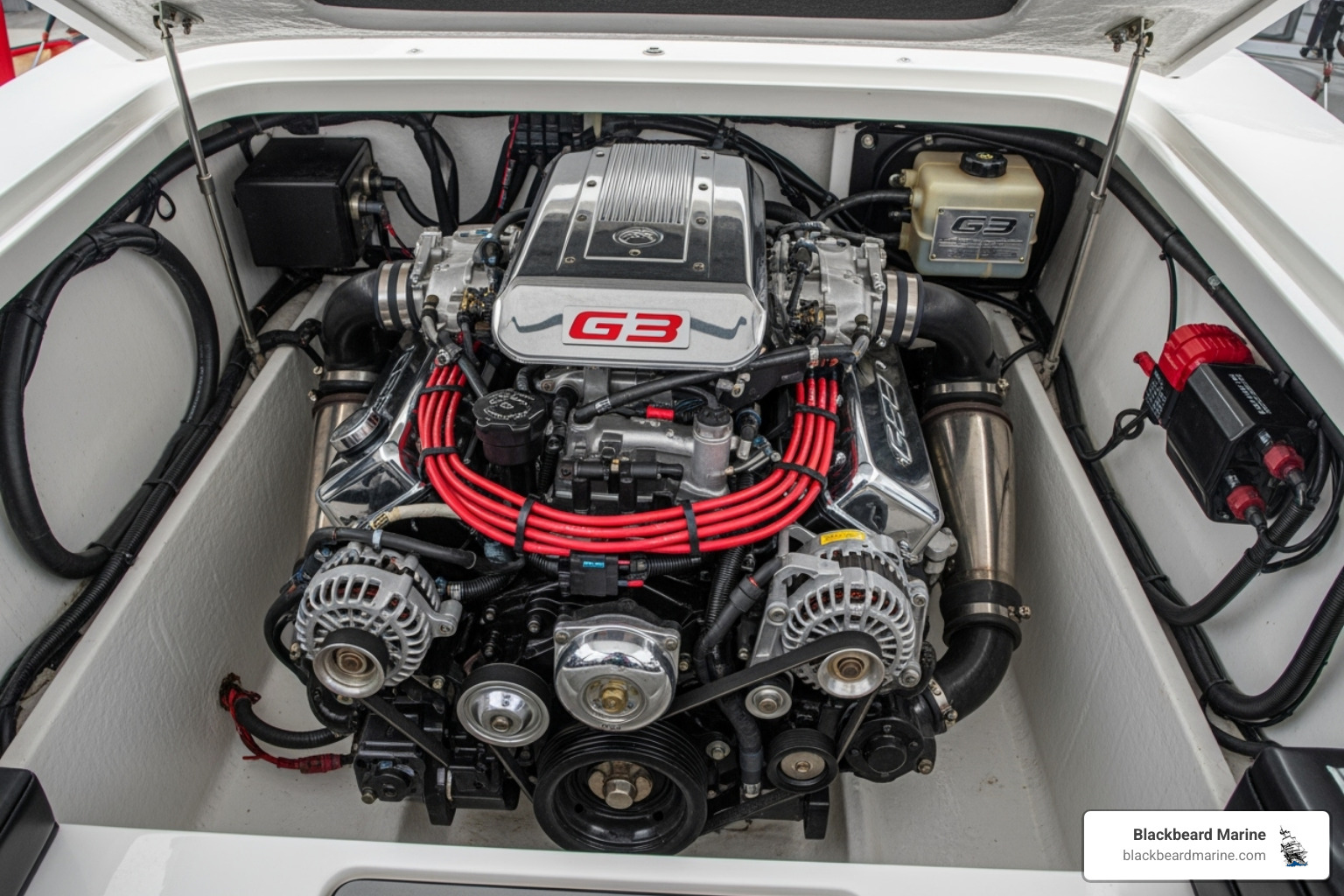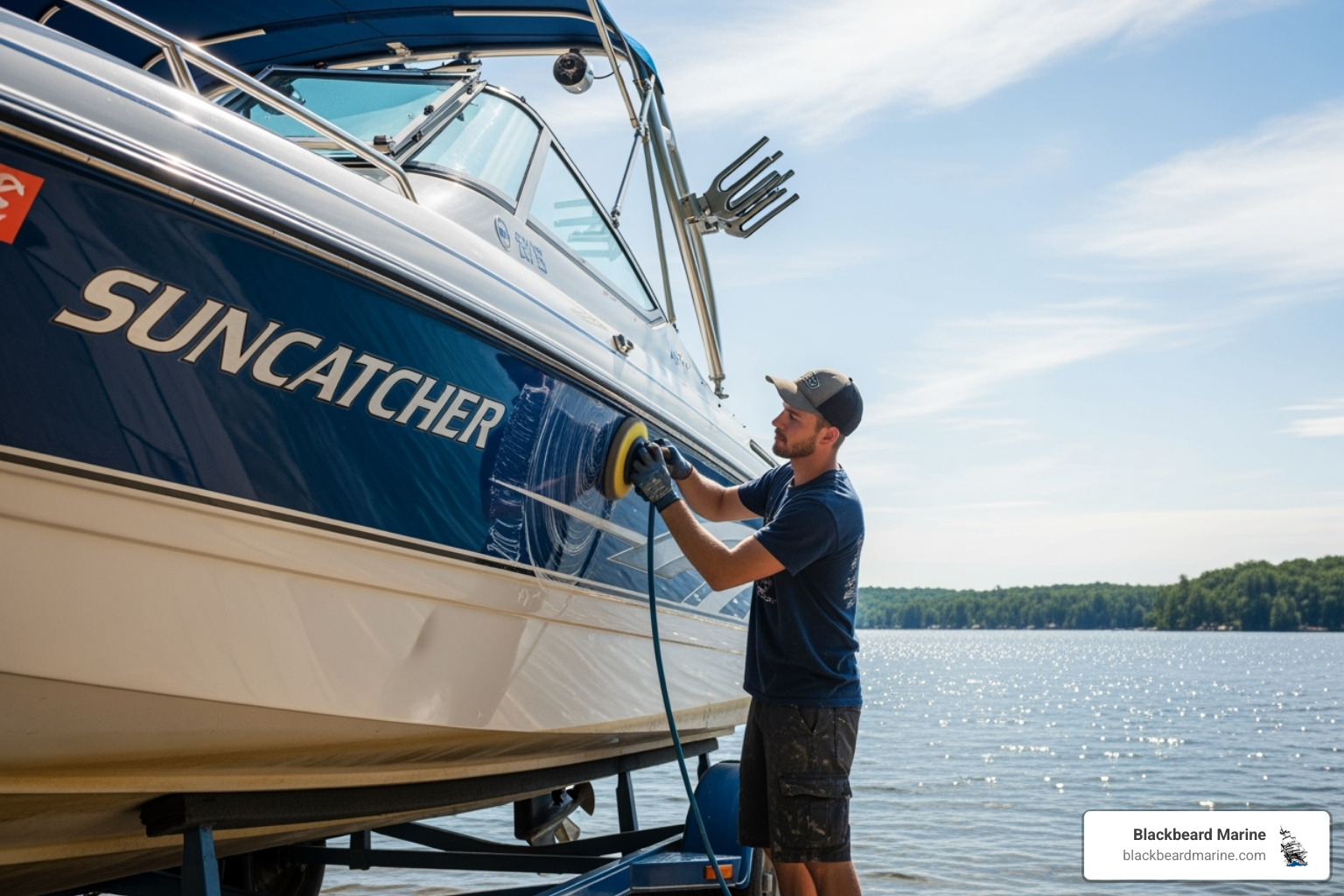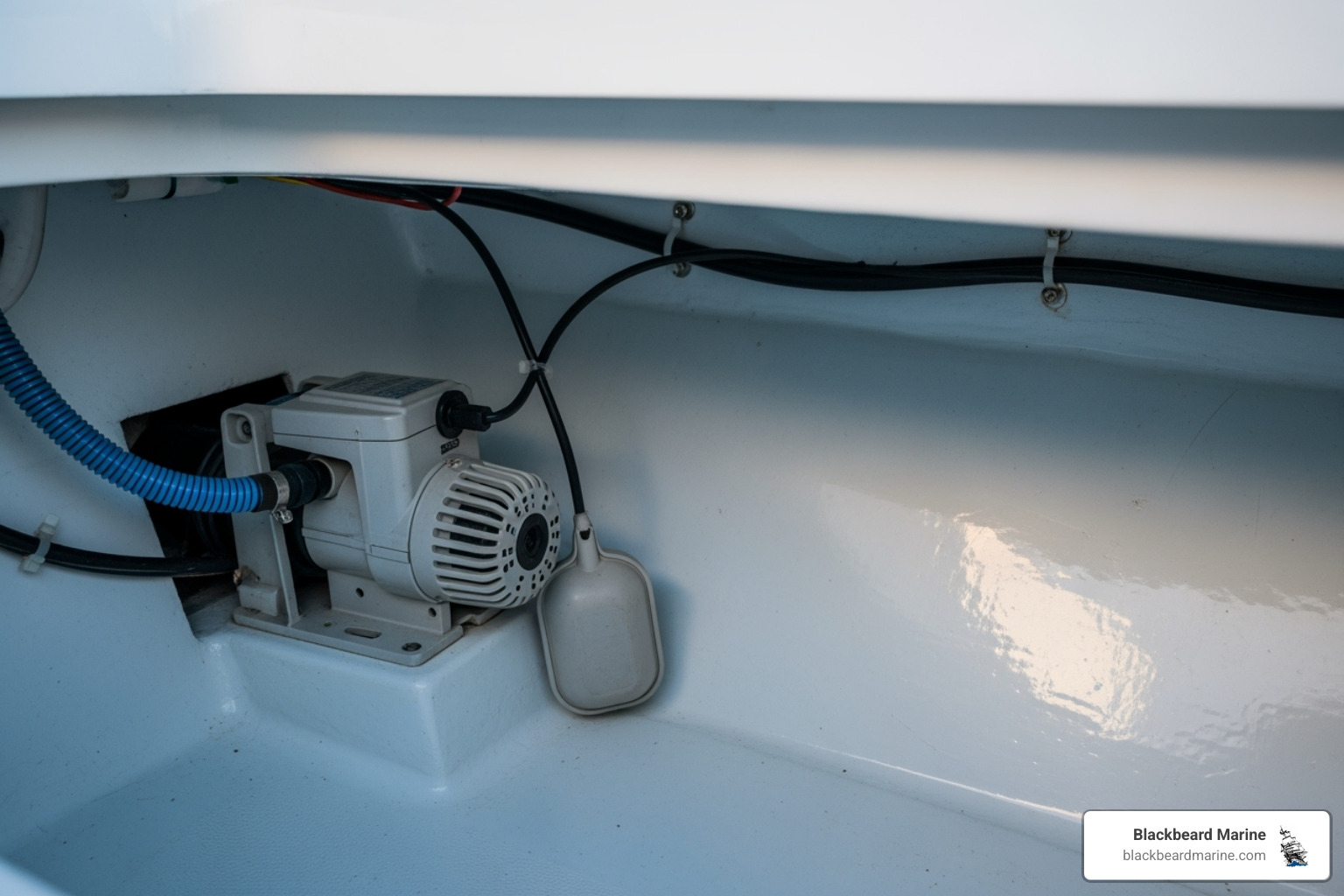Why Ski Boat Maintenance Tips Matter for Every Owner
Ski boat maintenance tips are essential for keeping your vessel running smoothly and safely, whether you’re on Lake Texoma or Table Rock Lake. Proper care protects your investment and ensures countless hours of family fun.
Essential Ski Boat Maintenance Checklist:
- Engine Care: Change oil every 50 hours or annually, check fluid levels, inspect belts and hoses.
- Fuel System: Use fuel stabilizer, replace filters, inspect lines for cracks.
- Exterior Protection: Wash after every use, wax hull 3 times per season, apply UV protectant.
- Seasonal Tasks: Winterize properly, perform spring prep, conduct mid-season inspections.
- Safety Checks: Test bilge pump, inspect thru-hull fittings, maintain trailer bearings.
- Saltwater Care: Flush engine thoroughly, rinse entire boat and trailer with fresh water.
Regular maintenance isn’t just about performance – it’s about safety. Proper upkeep prevents the majority of on-water breakdowns and costly repairs. Your Suncatcher, G3, or Lowe boat from Blackbeard Marine deserves the best care to extend its life, preserve its value, and keep your family safe.
A systematic maintenance routine is the key to a boat that runs for decades instead of becoming a costly headache.

Related content about Ski boat maintenance tips:
The Core of Your Ski Boat: Engine and Mechanical Systems
Your ski boat’s engine is its heart. Constant stopping and starting puts extra strain on the engine of your G3 or Lowe, so regular attention to all mechanical systems is critical for reliable performance.
Essential Engine and Mechanical Ski Boat Maintenance Tips
Prioritizing engine maintenance extends your boat’s lifespan and prevents costly headaches.

Here’s what we recommend:
- Oil and Filter Changes: Change your engine’s oil and filter every 50 hours of operation or at least once a year. This protects the engine from wear.
- Transmission and V-Drive Fluid: Check and service these fluids according to your owner’s manual to ensure smooth power delivery.
- Coolant Levels: Check coolant levels at the start of each season and periodically to prevent overheating.
- Inspecting Belts and Hoses: Before each season, inspect belts for fraying or cracking and hoses for leaks or bulges. A failed belt or hose can ruin a day on the lake.
- Impeller Inspection and Replacement: The water pump impeller is vital for cooling. A worn impeller can cause engine overheating, so inspect and replace it per your owner’s manual.
For more in-depth care, visit our team for expert assistance. More info about our boat maintenance services
Fuel System Integrity
An overlooked but common source of engine problems is the fuel system. Keeping it pristine is vital for performance.
- Ethanol-Free Fuel Benefits: If possible, use ethanol-free gasoline. If you use ethanol-containing fuel, always add a marine-grade fuel additive. Never use E15 fuel in a marine engine.
- Fuel Stabilizer Use: Add a fuel stabilizer if your boat sits for more than a few weeks, especially during off-season storage, to prevent fuel degradation. Run the engine for 10 minutes to circulate it.
- Fuel Filter Changes: Change fuel filters annually or per your engine manual’s intervals to protect your engine from contaminants.
- Inspecting Fuel Lines: Regularly inspect fuel lines for cracks or wear. Leaks are a serious safety hazard, so replace damaged hoses immediately.
- Keeping Tanks Full: Keep your fuel tank topped off during periods of inactivity to minimize condensation.
For fuel system concerns, our service department is ready to help. More info about our service and parts
Propulsion and Steering
Propulsion and steering systems endure significant stress and require regular attention.
- Propeller Inspection: Regularly inspect your propeller for dings, cracks, or bent blades. Minor damage can cause vibration and harm your drive train.
- Prop Shaft, Strut, and Cutlass Bearings: Have your prop shaft packing replaced as needed and cutlass bearings checked every 300 hours of use for smooth, vibration-free operation.
- Rudder Check: Inspect rudders and their posts for damage or looseness.
- Stuffing Box Adjustment: For inboard engines, have the stuffing box seal checked at the start of each season to prevent water ingress.
- Steering Cable Lubrication: Rotate your steering wheel lock-to-lock monthly to lubricate the cables and prevent seizing.
- Engine Alignment: Have engine alignment checked every 200 hours or two years to minimize vibration and wear.
Electrical System Health
Corrosion is the archenemy of your boat’s complex electrical system. Reliable power is essential for everything from starting the engine to running navigation systems.
- Battery Maintenance: Check your battery’s charge levels regularly and inspect the case for cracks or leaks. Replace it if it’s not holding a charge.
- Cleaning Terminals: Keep all battery terminals and electrical connections clean and free of corrosion, the primary cause of electrical failures.
- Applying Dielectric Grease: After cleaning, apply dielectric grease to terminals to prevent future corrosion.
- Inspecting Wiring: Regularly inspect all wiring for damage, ensuring all wires are securely fastened. Use marine-grade wire for all connections to resist corrosion.
- Testing Navigation Lights: Before every trip, test all navigation lights and other essential electronics.
Protecting Your Investment: Exterior and Interior Care
Protecting the exterior and interior of your Suncatcher or G3 keeps it looking great and performing well for years. Consistent care after each trip is the key to maintaining your boat’s value and preventing major headaches on Lake Texoma or Table Rock Lake.
Exterior and Hull Ski Boat Maintenance Tips
Your boat’s exterior takes a beating from sun and water, but keeping it in showroom condition is manageable with the right approach.

Washing after every use is the most important habit. A quick rinse with fresh water and marine-grade soap removes salt, dirt, and algae that can damage your boat’s finish.
Your waxing schedule should be three times per season (beginning, middle, and end). Marine wax acts like sunscreen, protecting against UV damage and corrosion while maintaining shine. Avoid waxing in direct sunlight or on non-skid surfaces.
Gelcoat polishing is needed when your boat’s finish looks dull from oxidation. A good polish before waxing can restore its original luster.
Don’t forget cleaning non-skid surfaces. A stiff brush and specialized cleaner will remove trapped dirt without damaging the texture.
Metal corrodes five times faster in saltwater than in freshwater. Regular care of all metal parts is essential to prevent costly replacements. Metal corrosion facts
Saltwater vs. Freshwater Care
Your maintenance routine depends on where you boat. Saltwater is more corrosive and demands extra vigilance.
| Feature | Freshwater Maintenance | Saltwater Maintenance |
|---|---|---|
| Engine | Flush engine after every use to remove debris. | Critical: Flush engine with freshwater for at least 10 minutes after every use to remove salt. |
| Hull | Wash hull after every use; inspect for algae. | Wash hull after every use; inspect for barnacles and salt buildup. Waxing helps. |
| Exterior | Rinse all surfaces with fresh water. | Rinse all exterior surfaces (tower, hardware, trailer) with fresh water to remove salt. |
| Metal Parts | Regular cleaning and inspection for rust. | Frequent: Inspect and clean all metal components for corrosion. |
| Anodes/Zincs | Inspect annually or as needed. | Crucial: Inspect sacrificial anodes (zincs) frequently and replace when 50% depleted. |
| Trailer | Rinse off dirt and debris. | Essential: Rinse the entire trailer with fresh water after every saltwater launch. |
| Interior | Wipe down and dry to prevent mold/mildew. | Wipe down and dry, paying attention to salt residue on upholstery. |
The bottom line: Saltwater requires immediate cleaning after every outing. With freshwater, you have more flexibility, but cleaning sooner is always better.
Interior Upholstery and Carpet Care
Keeping your boat’s interior clean and comfortable ensures everyone enjoys their time on the water.
Wipe down vinyl seats after each trip with mild soap and water to prevent stains from sunscreen and dirt. Use a damp sponge, not poured water.
Mildew prevention is critical. Ensure everything is completely dry before covering your boat. Tackle any mildew spots immediately with a vinegar solution or marine-specific cleaner.
UV protectant spray is like anti-aging cream for your vinyl. Apply it regularly to prevent fading and cracking from the sun’s harsh rays.
Vacuum carpets regularly to remove sand and dirt. If carpets get soaked, dry them completely to prevent mold and odors.
These ski boat maintenance tips protect your investment and keep your boat a welcoming place for your family.
Your Complete Guide to Seasonal Ski Boat Maintenance Tips
Seasonal ski boat maintenance tips are key to separating reliable boats from weekend headaches. Whether preparing for a spring trip to Lake Texoma or winterizing your Suncatcher, proper timing is crucial. Most problems arise from skipping small but vital checks that can prevent a tow back to the dock or costly freeze damage.
Before & After Every Trip Checklist
These simple checks take just minutes but prevent the majority of on-water breakdowns.
Before you launch:
- Ensure the drain plug is secure.
- Check that all safety gear is aboard and accessible (life jackets, fire extinguisher, distress signals). The Coast Guard offers free vessel safety checks. Get a free vessel safety check
- Run the bilge blower for at least 4 minutes before starting the engine to vent fumes.
- Check engine fluid levels (oil, coolant, power steering).
- Test your bilge pump and visually inspect the hull.
After every outing:
- Wipe down all surfaces to remove water spots, dirt, and salt residue.
- Flush your engine after every use, even in freshwater, to remove minerals and debris.
- Cover your boat to protect it from UV rays and weather.
Mid-Season and Annual Inspections
Deeper inspections help catch developing problems. We recommend these checks mid-season and annually, especially for boats that see heavy use on lakes like Table Rock.
- Hoses and clamps: Look for rust, wear, and loose connections.
- Engine mounts: Ensure all bolts are tight and secure to prevent vibration.
- Bilge pump and float switch: Test both components to ensure they activate properly.
- Electronics: Test all navigation equipment, depth finders, and entertainment systems. Check for damaged cables and clean connections.
- Steering and throttle cables: Address any stiffness or grinding sounds immediately. Proper lubrication is key.
- Propeller and drive system: Inspect for damage, check sacrificial anodes (zincs), and clear debris from through-hull fittings. These components on your Suncatcher, G3, or Lowe work hard and need regular attention. More info about Tigé boats (for comparison)
Preparing for Winter Storage (Winterization)
In Oklahoma and Missouri, proper winterization is essential to prevent catastrophic freeze damage. Water expands when it freezes, which can crack an engine block.
- Drain and flush the engine: Completely drain all water from the engine block, manifolds, and cooling system, then circulate marine-grade antifreeze.
- Stabilize the fuel: Top off the tank, add a quality marine fuel stabilizer, and run the engine briefly to distribute it.
- Fog the engine cylinders: Use fogging oil to create a protective coating on internal components to prevent rust.
- Remove and store batteries: Store batteries in a cool, dry place on a smart charger or maintainer to extend their life.
- Clean the boat: Clean the interior and exterior thoroughly, ensuring everything is dry to prevent mildew.
- Cover the boat: Use a quality, breathable boat cover or consider professional shrink-wrapping for maximum protection.
Spring Prep (De-Winterization)
Proper de-winterization ensures your first trip of the season to Table Rock Lake is a success.
- Reconnect the battery: Ensure terminals are clean and connections are tight.
- Check all fluid levels: Top off oil, coolant, and other fluids. Spring is a great time for an oil change if you didn’t do one in the fall.
- Inspect the water pump impeller: Replace it if there are any signs of wear.
- Check belts and hoses: Look for wear or damage that may have occurred during storage.
- Test all systems: Before launching, run the engine on a flush kit and test all electrical systems, lights, and steering.
- Inspect the trailer: Check tire pressure, grease wheel bearings, and test brakes and lights.
Safety First: Preventing Sinking and Trailer Mishaps
No one wants their G3 or Suncatcher at the bottom of Lake Texoma. Yet, for every boat that sinks underway, four sink at the dock. Repairs can cost 40% of the boat’s value. The good news is that most sinkings are preventable with proper ski boat maintenance tips and awareness.
Why Boats Sink and How to Prevent It
When a boat sinks at the dock, the question isn’t about the bilge pump, but where the water came from. Understanding the common causes is key to protecting your investment.

- Failed Underwater Fittings: Half of all dockside sinkings are due to failed fittings like stuffing boxes, thru-hulls, or outdrive bellows. Your Lowe or G3 has several of these critical points.
- Rain and Snow: These account for 32% of sinking claims. An open hatch or poorly fitted cover can let in enough water to overwhelm a bilge pump.
- Bilge Pump Issues: A bilge pump can mask a slow leak, giving false confidence. Keep your bilge clean and test the pump and float switch regularly.
- Thru-Hull Fittings: Every fitting below the waterline needs a working seacock (shutoff valve). Inspect fittings and hoses for wear or corrosion. Always double-clamp hoses below the waterline.
- I/O Drive Bellows: Inspect these rubber components several times a season for cracks. Storing the outdrive down helps prevent failure.
- Drain Plugs: A forgotten drain plug is a common and preventable cause of sinking. Make checking it part of your pre-launch ritual.
The U.S. Coast Guard Auxiliary offers free vessel safety inspections that can spot potential problems. Get a free vessel safety check
Essential Boat Trailer Maintenance
Your boat trailer works hard getting your Suncatcher or G3 to Table Rock Lake. A highway breakdown is dangerous and expensive.
- Tires: Check pressure and tread condition before every trip, including the spare.
- Lights and Wiring: Test all lights (running, brake, turn signals) before each trip. Look for frayed wiring and cracked lenses.
- Wheel Bearings: Use bearing protectors to check and add grease. Have bearings professionally repacked annually or every few thousand miles.
- Brakes: If your trailer has hydraulic brakes, check the fluid level regularly and replace the fluid every two years.
- Winch Strap and Safety Chains: Inspect the winch strap for fraying and ensure safety chains are securely attached and undamaged.
- Bunks/Rollers: Check for worn carpet or damaged rollers that could scratch your boat’s hull.
Frequently Asked Questions about Ski Boat Maintenance
At Blackbeard Marine, we help countless owners on Lake Texoma and Table Rock Lake keep their boats running smoothly. Here are the most common questions we hear about ski boat maintenance tips.
How often should I change my ski boat’s oil?
This is our most common question. Most manufacturers recommend changing the oil and filter every 50 hours of operation or at least once a year, whichever comes first. For many boaters, this means an annual change. Always check your owner’s manual for specific intervals for your G3, Skeeter, Suncatcher, or other model, as this also protects your warranty.
What is the most important step after using my boat in saltwater?
Flushing your engine’s cooling system with fresh water for 5-10 minutes is absolutely critical. Salt is incredibly corrosive. After flushing the engine, rinse the entire boat, trailer, and all gear with fresh water to remove salt deposits. Metal corrodes five times faster in saltwater, so don’t skip this step.
Can I perform all ski boat maintenance myself?
Some you can, some you shouldn’t. Routine tasks like cleaning, checking fluids, and visual inspections are great DIY projects. However, complex jobs like engine alignment, impeller replacement, or proper winterization require specialized tools and knowledge. A mistake can lead to catastrophic damage. Our rule of thumb: if it involves opening the engine or could sink your boat if done wrong, let the professionals at Blackbeard Marine handle it.
Keep Your Adventure Going with Proper Maintenance
Mastering these ski boat maintenance tips is about protecting your investment and the priceless moments on the water with family and friends. Consistent care is the key to years of reliable performance on lakes like Texoma and Table Rock.
- Engine Care: Regular oil changes and fluid checks are the heart of every adventure.
- Exterior & Interior Protection: Washing your boat and using UV protectant preserves its value and appearance.
- Seasonal Prep: Proper winterization and spring prep prevent costly damage and ensure a smooth start to the season.
- Safety First: Bilge pump checks and trailer maintenance protect what matters most—your loved ones.
The difference between a boat that provides decades of service and one that becomes a headache is consistent, proactive maintenance.
For expert assistance with any maintenance task, or to find your dream boat from brands like Suncatcher, G3, Skeeter, or Blazer Bay, our team at Blackbeard Marine is here to help. We are committed to keeping you on the water in Oklahoma and Missouri.
